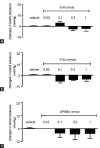A new therapeutic approach to erectile dysfunction: urotensin-II receptor high affinity agonist ligands
- PMID: 25080929
- PMCID: PMC4291883
- DOI: 10.4103/1008-682X.133322
A new therapeutic approach to erectile dysfunction: urotensin-II receptor high affinity agonist ligands
Abstract
Urotensin-II (U-II) is a cyclic peptide that acts through a G protein-coupled receptor (urotensin-II receptor [UTR]) mainly involved in cardiovascular function in humans. The urotensinergic system is also implicated in the urogenital tract. Indeed, U-II relaxes human corpus cavernosum strips and causes an increase in intracavernous pressure (ICP) in rats. In light of this, the U-II/UTR pathway can be considered a new target for the treatment of erectile dysfunction. On this hypothesis, herein we report on two new UTR high affinity-agonists, P5U (H-Asp-c[Pen-Phe-Trp-Lys-Tyr-Cys]-Val-OH) and UPG84(H-Asp-c[Pen-Phe-DTrp-Orn-(pNH 2 ) Phe-Cys]-Val-OH). The effects of P5U and UPG84 were each compared separately with U-II by monitoring the ICP in anesthetized rats. Intracavernous injection of U-II (0.03-1 nmol), P5U (0.03-1 nmol) or UPG84 (0.03-1 nmol) caused an increase in ICP. P5U, in particular, elicited a significant increase in ICP as compared to U-II. The observed effect by using P5U at a dose of 0.1 nmol per rat was comparable to the effect elicited by U-II at a dose of 0.3 nmol. Moreover, UPG84 at the lowest dose (0.03 nmol) showed an effect similar to the highest dose of U-II (1 nmol). Furthermore, UPG84 was found to be more effective than P5U. Indeed, while the lowest dose of P5U (0.03 nmol) did not affect the ICP, UPG84, at the same dose, induced a prominent penile erection in rat. These compounds did not modify the blood pressure, which indicates a good safety profile. In conclusion, UPG84 and P5U may open new perspectives for the management of erectile dysfunction.
Figures




References
-
- Vaudry H, Do Rego JC, Le Mevel JC, Chatenet D, Tostivint H, et al. Urotensin II, from fish to human. Ann N Y Acad Sci. 2010;1200:53–66. - PubMed
-
- Conlon JM, Yano K, Waugh D, Hazon N. Distribution and molecular forms of urotensin II and its role in cardiovascular regulation in vertebrates. J Exp Zool. 1996;275:226–38. - PubMed
-
- Ames RS, Sarau HM, Chambers JK, Willette RN, Aiyar NV, et al. Human urotensin-II is a potent vasoconstrictor and agonist for the orphan receptor GPR14. Nature. 1999;401:282–6. - PubMed
-
- Grieco P, Franco R, Bozzuto G, Toccacieli L, Sgambato A, et al. Urotensin II receptor predicts the clinical outcome of prostate cancer patients and is involved in the regulation of motility of prostate adenocarcinoma cells. J Cell Biochem. 2011;112:341–53. - PubMed
-
- d’Emmanuele di Villa Bianca R, Cirino G, Mitidieri E, Coletta C, Grassia G, et al. Urotensin II: a novel target in human corpus cavernosum. J Sex Med. 2010;7:1778–86. - PubMed
Publication types
MeSH terms
Substances
LinkOut - more resources
Full Text Sources
Medical

